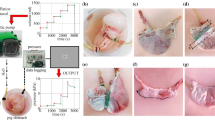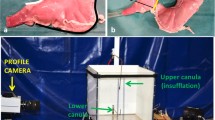Abstract
Background
Previous studies have indicated that pouch volume and stoma size are two important factors related to weight loss after laparoscopic gastric banding in morbid obese patients. We hypothesized that there was association among the wall stress, pouch volume, and stoma size in a model for the filling and emptying phases of the pouch.
Methods
A numerical pouch model with variable pouch volume and stoma size was generated. Uniaxial tensile testing was performed on fundus strips from fresh pig stomach and the mass flow of filling and emptying of the pouch was simulated numerically.
Results
There was an overall qualitative agreement on the volume change between the simulated results and the clinical recording. Increasing the pouch volume size from 22 to 105 ml caused a decrease of the maximum circumferential stress from 14.14 to 11.80 kPa and the maximum longitudinal stress from 9.87 to 6.70 kPa in the pouch wall at the same degree of filling. Decreasing the stoma diameter from 27 to 10 mm caused an increase of the maximum circumferential stress from 11.46 to 12.78 kPa and a decrease of the maximum longitudinal stress from 10.34 to 8.69 kPa.
Conclusion
Both the pouch volume and stoma size are important determinants of mechanical wall stress, wall strain, and pouch emptying and hence may affect satiety and weight loss. This information may be important in understanding the mechanical behavior of pouches and for the development of more advanced numerical models in the clinical management of the surgery.




Similar content being viewed by others
References
Flegal KM, Carroll MD, Ogden CL, et al. Prevalence and trends in obesity among US adults, 1999–2000. JAMA 2002;288:1723–7.
Jung RT. Obesity as a disease. Br Med Bull 1997;53:307–21.
Seidell JC, Visscher TLS, Hoogeveen RT. Overweight and obesity in the mortality rate data: current evidence and research issues. Med Sci Sports Exerc 1999;31 Suppl:S597–601.
Allison DB, Fontaine KR, Manson JE, et al. Annual deaths attributable to obesity in the United States. JAMA 1999;282:1530–8.
Goldstein J. Beneficial health effects of modest weight loss. Int J Obes 1991;16:397–415.
North American Association for the Study of Obesity and the National Heart, Lung and Blood Institute. The practical guide: identification, evaluation, and treatment of overweight and obesity in adults. NIH publication 00-4084. Bethesda, MD: National Institute of Health; 2000.
Buchwald HB, Avidor Y, Braunwald E, et al. Bariatic surgery: a systematic review and meta-analysis. JAMA 2005;292:1724–37.
Mistiaen W, Vaneerdeweg W, Blockx P, et al. Gastric emptying rate measurement after vertical banded gastroplasty. Obes Surg 2000;10:245–9.
Naslund E, Backman L, Granstrom L, et al. Does the size of the upper pouch affect weight loss after vertical banded gastroplasty. Obes Surg 1995;5:378–81.
Naslund I, Beckman KW. Gastric emptying rate after gastric bypass and gastroplasty. Scand J Gastroenterol 1987;22:193–201.
Roberts K, Duffy A, Kaufman J, et al. Size matters: gastric pouch size correlates with weight loss after laparoscopic Roux-en-Y gastric bypass. Surg Endosc 2007;21:1397–402.
Forsell P. Pouch volume, stoma diameter and weight loss in Swedish Adjustable Gastric Banding (SAGB). Obes Surg 1996;6:468–73.
Andersen T. Obsity in Europe: chapter 28, changes and hazards of the mechanistic approach in the treatment of obesity. Eastleigh: Libbey; 1993. p. 179–84.
Phillips RJ, Powley TL. Tension and stretch receptors in gastrointestinal smooth muscle: re-evaluating vagal mechanoreceptor electrophysiology. Brain Res Rev 2000;34:1–26.
Andersen T. Gastroplasty and very-low-calorie diet in the treatment of morbid obesity. Lægeforeningens orlage, 1990. Københavns Univeristitet.
Gregersen H. Biomechanics of the gastrointestinal tract. New perspectives in motility research and diagnostics. London: Springer; 2002. p. 137–255.
Zhao J, Liao D, Gregersen H. Tension and stress in the rat and rabbit stomach are location- and direction-dependent. Neurogastroenterol Motil 2005;17:388–98.
Sultan M, Richard A. Norton, esophageal diameter and the treatment of achalasia. Dig Dis Sci 1969;14:611–8.
Pickhardt PJ, Asher DB. Wall thickening of the gastric antrum as a normal finding: multidetector CT with cadaveric comparison. Am J Roentgenol 2003;181:973–9.
Liao D, Gregersen H, Hausken T, et al. Analysis of surface geometry of the human stomach using real-time 3D ultrasonography. Neurogastroenterol Motil 2004;16:315–24
Liao D, Zhao J, Gregersen H. Regional surface geometry of the rat stomach based on three dimensional curvature analysis. Phys Med Biol 2005;50:231–46.
Liao D, Zhao J, Gregersen H. Three-dimensional geometry analysis of the stomach in type II diabetic GK rats. Diabetes Res Clin Pract 2006;71:1–13.
Backman L, Rosenborg M. The significance of gastric pouch size and emptying time for results of gastric surgery for massive obesity. Acta Chir Scand 1984;150:549–55.
Dockray GJ. Gut feelings about appetite. Eur Rev 2004;12:217–25.
Raybould HE, Gayton RJ, Dockray GJ. Mechanisms of action of peripherally administered cholecystokinin octapeptide on brain stem neurons in the rat. J Neurosci 1998;8:3018–24.
Suter M, Giusti V, Worreth M, et al. Laparoscopic gastric banding: a prospective, randomized study comparing the lapband and the SAGB: early results. Ann Surg 2005;241:55–62.
Ceelen W, Walder J, Cardon A, et al. Surgical treatment of severe obesity with a low-pressure adjustable gastric band. Ann Surg 2003;237:10–6.
Li M, Brasseur JG, Dodds WJ. Analyses of normal and abnormal esophageal transport using computer simulations. Am J Physiol 1994;266:G525–43.
Acknowledgement
Dr. Jan Petersen is kindly thanked for providing the clinical data.
Author information
Authors and Affiliations
Corresponding author
Rights and permissions
About this article
Cite this article
Gao, F., Liao, D., Zhao, J. et al. Numerical Analysis of Pouch Filling and Emptying After Laparoscopic Gastric Banding Surgery. OBES SURG 18, 243–250 (2008). https://doi.org/10.1007/s11695-007-9314-9
Received:
Accepted:
Published:
Issue Date:
DOI: https://doi.org/10.1007/s11695-007-9314-9




